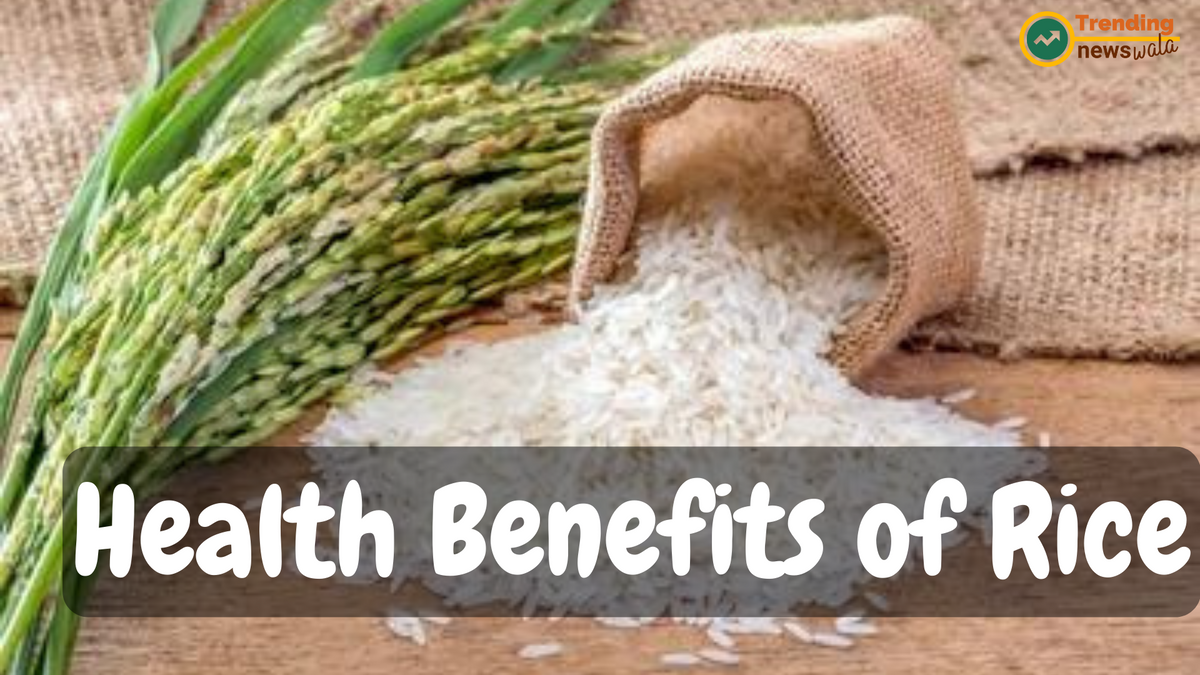10 Health Benefits of Rice

Rice is a cereal grain that is one of the most important staple foods in the world. It is the most widely consumed staple food for a large part of the world's population, particularly in Asia and Africa. Rice is a member of the grass family and is grown as an annual crop. It is a major source of dietary carbohydrates and provides essential nutrients such as thiamin, riboflavin, niacin, iron, and vitamin D. There are many different varieties of rice, each with its own unique flavor and texture, and it can be cooked in a variety of ways including boiling, steaming, and frying.
Rice can be consumed on its own as a side dish, or as an ingredient in a variety of dishes including soups, stews, salads, and casseroles. It can also be ground into flour and used to make bread, noodles, and other baked goods. Rice is gluten-free, which makes it a popular substitute for wheat-based products for people with celiac disease or gluten intolerance.
Rice cultivation dates back thousands of years and has been a staple food for civilizations across the world. It is believed to have originated in China and later spread to other parts of Asia, Europe, and Africa. Today, rice is grown in many countries around the world, with China, India, and Indonesia being the top three producers.
Nutritional profile of rice
The nutritional profile of rice can vary depending on the type of rice and how it is prepared. Here is a general overview of the nutritional content of 1 cup (195 grams) of cooked long-grain white rice:
- Calories: 205
- Carbohydrates: 45 grams
- Protein: 4.3 grams
- Fat: 0.4 grams
- Fiber: 0.6 grams
- Thiamin (vitamin B1): 0.2 milligrams (15% of the Daily Value)
- Niacin (vitamin B3): 2.0 milligrams (13% of the Daily Value)
- Vitamin B6: 0.2 milligrams (12% of the Daily Value)
- Folate (vitamin B9): 15 micrograms (4% of the Daily Value)
- Iron: 0.8 milligrams (4% of the Daily Value)
Brown rice, on the other hand, has a higher nutritional value as it is a whole grain and contains the bran and germ layers of the rice grain. Here is a general overview of the nutritional content of 1 cup (195 grams) of cooked long-grain brown rice:
- Calories: 218
- Carbohydrates: 45 grams
- Protein: 5 grams
- Fat: 1.8 grams
- Fiber: 3.5 grams
- Thiamin (vitamin B1): 0.3 milligrams (25% of the Daily Value)
- Niacin (vitamin B3): 3.2 milligrams (20% of the Daily Value)
- Vitamin B6: 0.4 milligrams (23% of the Daily Value)
- Folate (vitamin B9): 10 micrograms (3% of the Daily Value)
- Iron: 1.8 milligrams (10% of the Daily Value)
Overall, rice is a good source of carbohydrates and essential nutrients such as thiamin, niacin, and vitamin B6. However, it is relatively low in fiber, which is an important nutrient for digestive health. Adding vegetables, beans, or other sources of fiber to a meal that includes rice can help to increase its nutritional value.
10 top health benefits of rice?
Here are 10 top health benefits of rice:
1. Provides energy: Rice is a good source of carbohydrates, which provide energy to the body. It is an ideal food for athletes and people who engage in physical activities.
2. Promotes digestion: Rice is easy to digest and is a good source of fiber, which helps to promote bowel regularity and prevent constipation.
3. Lowers cholesterol: Brown rice contains a type of fiber called soluble fiber, which can help to lower cholesterol levels in the blood and reduce the risk of heart disease.
4. Regulates blood sugar: Brown rice has a lower glycemic index than white rice, which means it releases sugar into the bloodstream at a slower rate. This can help to regulate blood sugar levels and reduce the risk of type 2 diabetes.
5. Supports bone health: Brown rice is a good source of magnesium, which is essential for healthy bones. It also contains calcium and vitamin D, which are important for bone health.
6. Reduces the risk of cancer: Brown rice contains a compound called lignan, which has been shown to reduce the risk of breast cancer and other hormone-related cancers.
7. Boosts immunity: Brown rice contains a variety of vitamins and minerals, including vitamin E, selenium, and zinc, which are important for a healthy immune system.
8. Promotes weight loss: Brown rice is a low-calorie, high-fiber food that can help to promote feelings of fullness and reduce overall calorie intake. This can lead to weight loss over time.
9. Supports healthy skin: Brown rice contains a variety of antioxidants, which can help to protect the skin from damage caused by free radicals and promote healthy, glowing skin.
10. Provides essential nutrients: Rice is a good source of essential nutrients such as thiamin, niacin, and vitamin B6, which are important for overall health and wellbeing.
Is rice safe for everyone?
In general, rice is safe for most people to consume as part of a healthy, balanced diet. However, there are some exceptions:
1. People with celiac disease or gluten intolerance: Some types of rice, such as glutinous rice, are naturally gluten-free. However, rice can be contaminated with gluten during processing or cooking, so it is important for people with celiac disease or gluten intolerance to choose certified gluten-free rice products.
2. Infants and young children: Rice products, particularly those made from white rice, may contain high levels of arsenic, which can be harmful to infants and young children. It is recommended that infants and young children limit their consumption of rice and rice products, and that parents choose rice products that are lower in arsenic or switch to other grains such as quinoa, barley, or oatmeal.
3. People with diabetes: Although rice is a good source of carbohydrates, people with diabetes should be careful about the amount and type of rice they consume. Brown rice has a lower glycemic index than white rice, which means it releases sugar into the bloodstream at a slower rate. People with diabetes may want to choose brown rice over white rice and limit their portion sizes.
4. People with kidney disease: Rice is relatively low in potassium and phosphorus, which makes it a good choice for people with kidney disease who need to limit their intake of these minerals. However, people with advanced kidney disease may need to limit their intake of rice due to its high potassium content.
As with any food, it is important to consume rice in moderation as part of a healthy, balanced diet. If you have any concerns about consuming rice or any other food, it is always a good idea to consult with a healthcare professional or a registered dietitian.
Rice recipes
Here are three rice recipes that you may enjoy:
1. Fried Rice:
- Heat 1 tablespoon of oil in a large skillet over medium-high heat.
- Add 2 beaten eggs and scramble until set. Remove from the skillet and set aside.
- Add another tablespoon of oil to the skillet and add 1 diced onion, 1 diced red pepper, and 2 cloves of minced garlic. Cook until softened.
- Add 4 cups of cooked rice (preferably day-old), 1 cup of frozen peas and carrots, 1 tablespoon of soy sauce, and 1 teaspoon of sesame oil. Cook until heated through, stirring occasionally.
- Add the scrambled eggs back to the skillet and stir to combine. Serve hot.
2. Spanish Rice:
- Heat 1 tablespoon of oil in a large pot over medium-high heat.
- Add 1 diced onion and 2 cloves of minced garlic. Cook until softened.
- Add 2 cups of uncooked white rice and cook, stirring constantly, for 2-3 minutes or until lightly browned.
- Add 1 can of diced tomatoes (undrained), 2 cups of chicken broth, 1 teaspoon of salt, and 1 teaspoon of paprika. Stir to combine.
- Bring the mixture to a boil, then reduce the heat to low and cover the pot. Cook for 18-20 minutes or until the rice is tender and the liquid is absorbed. Fluff with a fork and serve hot.
3. Coconut Rice:
- Rinse 1 cup of jasmine rice in a fine mesh strainer until the water runs clear. Set aside.
- In a medium saucepan, combine 1 can of coconut milk, 1 cup of water, and 1 teaspoon of salt. Bring to a boil over medium-high heat.
- Add the rinsed rice to the saucepan and stir to combine.
- Reduce the heat to low, cover the saucepan, and simmer for 18-20 minutes or until the liquid is absorbed and the rice is tender.
- Remove the saucepan from the heat and let it sit, covered, for 5-10 minutes.
- Fluff the rice with a fork and serve hot. Optional: top with chopped fresh cilantro or sliced green onions.
Q: What are the health benefits of rice?
A: Rice is a great source of carbohydrates, fiber, and essential nutrients like vitamins and minerals. It is also gluten-free and low in fat, making it a healthy choice for a balanced diet.
Q: What nutrients are found in rice?
A: Rice contains complex carbohydrates, which provide energy to the body, as well as fiber, which aids in digestion. It also contains essential vitamins and minerals like vitamin B6, thiamine, niacin, iron, and potassium.
Q: Can rice help with weight loss?
A: Rice can be a part of a healthy weight loss plan when consumed in moderation. As it is low in fat and high in fiber, it can help you feel full and satisfied, reducing the likelihood of overeating.
Q: Is brown rice healthier than white rice?
A: Brown rice is considered healthier than white rice because it contains the bran and germ, which are rich in fiber, vitamins, and minerals. White rice, on the other hand, has been stripped of these nutrients during the refining process.
Q: Can rice help lower cholesterol?
A: Rice can help lower cholesterol levels as it is low in saturated fat and contains fiber, which can help reduce the absorption of cholesterol in the body.
Q: Does rice contain gluten?
A: Rice is gluten-free, making it a great option for those with gluten intolerance or celiac disease.
Q: Can rice be a part of a diabetic diet?
A: Rice can be a part of a diabetic diet when consumed in moderation and in combination with other healthy foods. Brown rice is a better choice than white rice as it has a lower glycemic index, which means it does not cause a rapid spike in blood sugar levels.
Q: Is rice safe for those with food allergies?
A: Rice is generally considered safe for those with food allergies, but it is important to check for cross-contamination or additives that may contain allergens.
Q: Can rice help improve digestion?
A: Rice is a good source of fiber, which can help promote healthy digestion by preventing constipation and maintaining regular bowel movements.
Q: Can rice help improve heart health?
A: Rice can help improve heart health as it is low in saturated fat and contains fiber, which can help lower cholesterol levels and reduce the risk of heart disease.





